
Vienna’s zoo (Tiergarten Schönbrunn) features hundreds of different mammals, birds, reptiles, amphibians, insects, fish and more, often housed in special themed indoor and outdoor enclosures.
Find my personal list of the most memorable attractions below.
- Book Vienna zoo tickets* online
- See also:
What animals are in the zoo?
Let us begin with the jewel in Tiergarten Schönbrunn’s crown…
Pandas
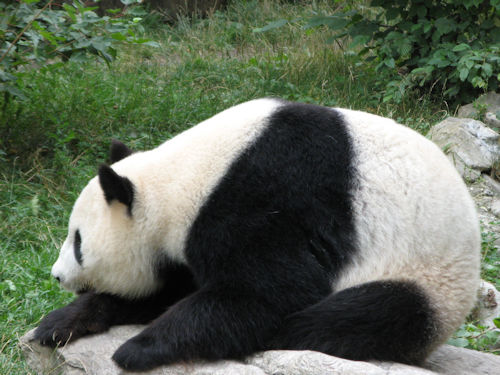
(A giant panda)
Ok, this is the big one.
Don’t go home without seeing Yang Yang and Yuan Yuan, the giant pandas, who have a lovely place close to the main zoo entrance.
Also…another leafy enclosure at the far side of the outdoor panda compound offers a home to something almost as cute: the red pandas.
Regenwaldhaus
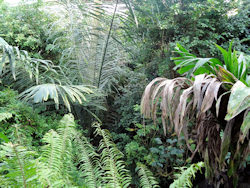
The rainforest house consists of a huge split-level glassed enclosure reproducing the conditions in a — surprise, surprise — rainforest, complete with artificial thunderstorms.
You wander around the floor and canopy of a tropical forest, with its free-living birds, bats and other animals.
Pools and mini-enclosures dot the complex, providing homes for the likes of Asian small-clawed otters and vampire crabs (not quite as exciting as they sound).
Not to mention a bat cave. With actual bats. In a cave.
It all makes for a rather lovely experience. However, inside can get hot and close, so be careful if your lungs and circulation don’t agree with that kind of climate.
And, if the weather’s chilly, your glasses and camera lenses fog up – use the hot air-blowing model lizards at each entrance to warm them up before going in.
(NB: Parts of the rainforest house may be inaccessible during a renovation programme expected to last until the end of 2024.)
Aquarium
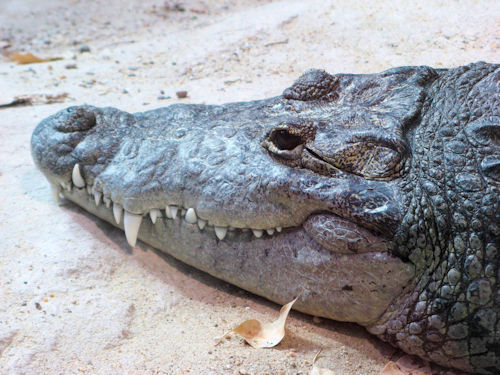
(Do not pet)
The first section of the aquarium and terrarium is a largish open water area with crocodiles, fish, and free-living birds and butterflies.
Glass butterfly breeding containers along the sides typically feature row upon row of chrysalises and freshly-popped butterflies experiencing their first (brief) taste of freedom.
The second section has the aquarium tanks with the usual denizens of the sea on display. View a large 80,000 liter reef aquarium, replete with shoals of brightly-colored fish, anemones, and corals.
(The bench opposite the reef makes an ideal spot for a snack while you watch the undersea world go by.)
The exit into the terrarium section takes you through a 7.5m glass tunnel construction mimicking a flooded Amazon forest floor. Perhaps your only chance to ever see stingrays from below.
The final section (terrarium) has snakes, frogs, lizards, the odd spider, ant tubes and chambers, and similar.
A darkened area (depending on the time of day) lets you see bats and scorpions going about their nightly business. (Though, frankly, scorpions at night don’t exactly sprint around entertainingly.)
Polar bear world

One of the more recent attractions at the zoo is a giant tiered enclosure for the polar bears that includes a central multi-storey dome full of information and displays about the animals and the polar environment.
With a bit of luck, you can watch the polar bears underwater.
Elephant house
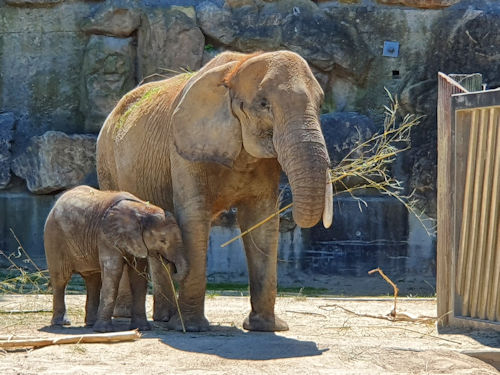
(Mother and calf)
The African elephants have a generous enclosure and house when compared to most other zoo elephants. Kids love the training routines, where the keepers put the animals through their paces.
Big cat house
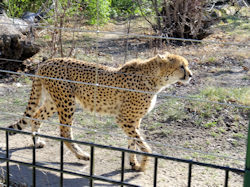
Tigers, cheetahs, and leopards occupy rooms and outdoor areas in the big cat house.
In a reflection of progress, the cheetahs now live in the areas previously reserved for visitors.
And the visitors watch the cheetahs from the safety of the old — tiny — big cat cages.
Rhino house

(Not as grumpy as it looks)
An extensive house and enclosure now hosts various Asiatic mammals, including an Indian rhinoceros pair (a gift from the Kingdom of Nepal).
Polarium
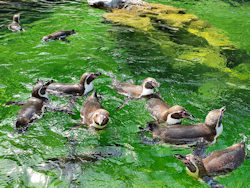
The polarium area has numerous penguins and an extended pool for the sea lions.
Feeding time for the sea lions involves plenty of large sea mammals jumping about, trying various tricks to cadge extra fish, and ensuring a free shower for visitors daring (or foolish) enough to stand too close.
Get there early if you want a good spot.
The Insektarium

(One of the more cuddly animals in the Insektarium. Really.)
Most of the information inside the Insektarium building is in German, but, hey, who doesn’t want to see a huge stick insect or a giant mantis?
A good place to take the kids. It keeps them busy as they search for the insect in the terrarium. Then watch them squirm when they do find it. Possibly educational. Possibly the stuff of nightmares.
The Tirolerhof
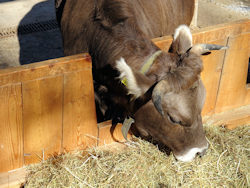
A walk up the back of the zoo takes you to a large farmhouse with various domestic animals on display. See this separate article for details.
(Can I suggest you pop into the farm shop at the Tirolerhof for some mountain cheese sharper than an extra-sharp pencil that’s just won this year’s Mr. Sharp competition?)
Other animals

(A rare moment awake)
Outside of these main centers you’ll find numerous other animals, including a modern giraffe house, the ORANG.erie Orang-Utan enclosure, zebra and antelope, lions, a koala house, a monkey and ape house, a bird house, a gibbon island, meerkats, reindeer, camels and, and, and…
Yes, it’s a big zoo.
For more information on visiting, check the visitor and tickets tips.